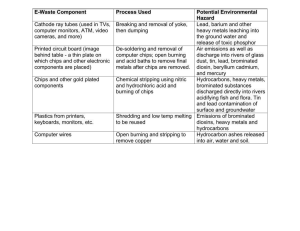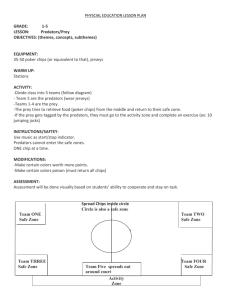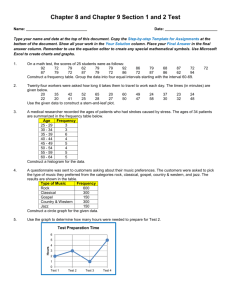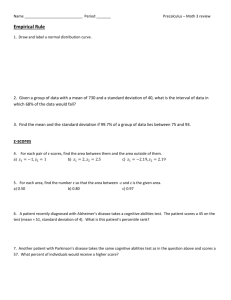Test 4 Sample Problem Solutions Convert from a decimal to a
advertisement
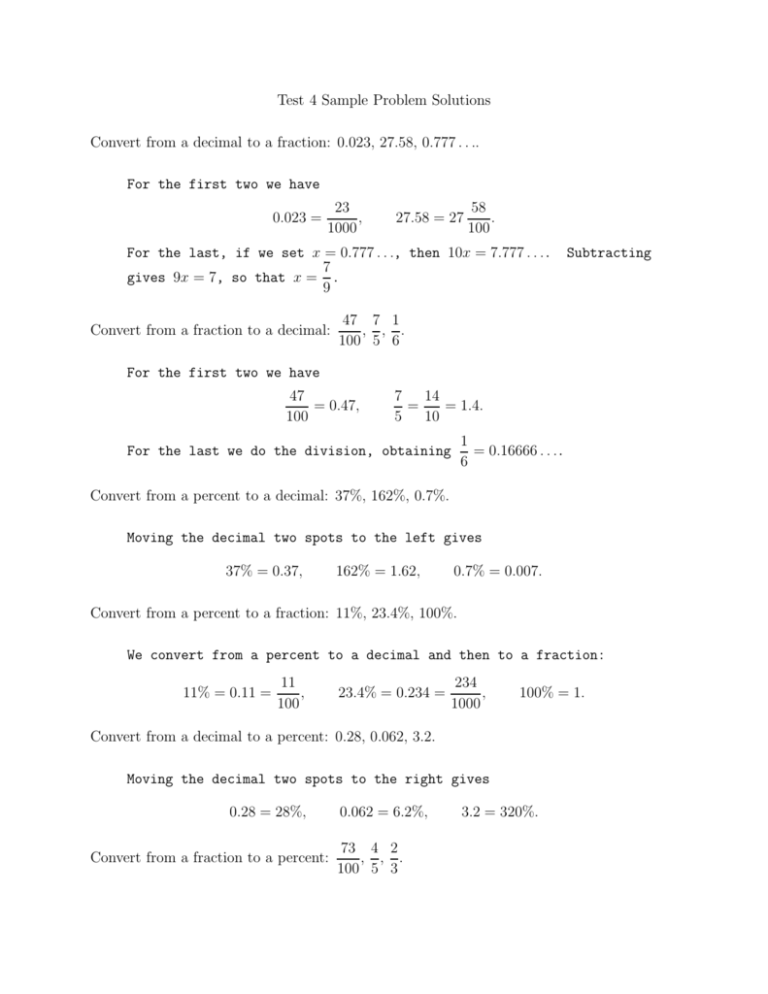
Test 4 Sample Problem Solutions Convert from a decimal to a fraction: 0.023, 27.58, 0.777 . . .. For the first two we have 0.023 = 23 , 1000 27.58 = 27 58 . 100 For the last, if we set x = 0.777 . . ., then 10x = 7.777 . . .. 7 gives 9x = 7, so that x = . 9 Convert from a fraction to a decimal: Subtracting 47 7 1 , , . 100 5 6 For the first two we have 47 = 0.47, 100 7 14 = = 1.4. 5 10 1 = 0.16666 . . .. 6 For the last we do the division, obtaining Convert from a percent to a decimal: 37%, 162%, 0.7%. Moving the decimal two spots to the left gives 37% = 0.37, 162% = 1.62, 0.7% = 0.007. Convert from a percent to a fraction: 11%, 23.4%, 100%. We convert from a percent to a decimal and then to a fraction: 11% = 0.11 = 11 , 100 23.4% = 0.234 = 234 , 1000 100% = 1. Convert from a decimal to a percent: 0.28, 0.062, 3.2. Moving the decimal two spots to the right gives 0.28 = 28%, Convert from a fraction to a percent: 0.062 = 6.2%, 73 4 2 , , . 100 5 3 3.2 = 320%. We convert from a fraction to a decimal and then to a percent: 73 = 0.73 = 73%, 100 4 8 = = 0.8 = 80%, 5 10 2 = 0.66 . . . = 66.66 . . . %. 3 Write these decimals in expanded form: 23.64, 0.028, 2.004. 23.64 = 23 + 6 4 + , 10 100 0.028 = 2 8 + , 100 1000 2.004 = 2 + 4 . 1000 Arrange these decimals in order from smallest to largest: 0.37, 0.6, 0.073. Writing them with the same number of decimal places gives 0.370, 0.600, and 0.073, at which point the order becomes clear: 0.073, 0.370, 0.600. Compute: 48.62 + 5.009; 10.33 − 0.72; 48.6 × 52.07; 2.3 ÷ 0.4. 53.629, 9.61, 2530.602, 5.75 A fruit basket contains five apples, eight oranges, and ten bananas. What fraction of the fruit is apples? What is the ratio of apples to bananas? What fraction of the fruit is not oranges? 5 Apples to total is . 23 18 . to total is 23 Solve for x: Apples to bananas is 5 1 = . 10 2 Not-oranges x 2 45 30 = ; = . 35 7 100 x Cros multiplying gives 7x = 70 so that x = 10. 3000 200 2 have 45x = 3000 so x = = = 66 . 45 3 3 For the second we A family uses 5 gallons of milk every 3 weeks. How many gallons will they need to purchase over a 2 month period? (Assume 30 days in a month.) They use five gallons in 21 days and x gallons in 60 days. This gives 5 x the proportion = , which we solve by cross-multiplying, obtaining 21 60 2 100 = 14 . 21x = 300, so x = 7 7 On a map, 1/3 inch equals 15 miles. The distance between two towns on a map is 3 32 inches. How many miles are actually between the two towns? Since 1/3 of an inch corresponds to 15 miles and 3 23 inches corresponds to x miles, we have the equation 32 1/3 = 3. 15 x Cross-multiplying gives x = 55 so that x = 165 miles. 3 It takes 10,000 silkworms to make one pound of silk. How many silkworms are needed to make one ounce of silk? (There are 16 ounces in a pound.) We know that 10,000 worms make 16 ounces and x worms make one ounce. x 10,000 = , so x = 10,000/16 = 625 worms. So we have the equation 16 1 Find 23% of 80. 0.23 × 80 = 18.4 Find 400% of 3. 4 × 3 = 12 Find 15 % of 50. Since 1/5 = 0.2, we have that 1/5% = 0.2% = 0.002. So 0.002 × 50 = 0.1 A dress costs $75 but is on sale for 30% off. What is the new price? Thirty percent of 75 is .3 × 75 = 22.5, so the new price is 75 − 22.5 = 52.5, which is $52.50. A dress is on sale for $50, after having been marked down by 10%. What was the original price? If you take 10% off the original price, the new sale price is 90% the original. Thus the question is, 50 is 90% of what? This leads to the equation .9 × P = 50, so that P = $55.55. Model the following using colored chips. Do each of them in two ways: as a subtraction problem and as an addition problem where the second number is negative: 7 − 5; 5 − 7; −3 − 2; −3 − 5. For 7−5, we begin with seven ⊕ chips and take five away, leaving two ⊕ chips remaining. For 7+(−5) we begin with seven ⊕ chips and add five ⊖ chips. Since this gives us mixed chips, we remove them a ⊕/⊖ pair at a time, leaving two ⊕ chips remaining. For 5 − 7 we begin with five ⊕ chips and we want to take away seven ⊕ chips. Since we’re two ⊕ chips short, we add two ⊕/⊖ pairs, allowing us now to remove the seven ⊕ chips. When this is done, two ⊖ chips remain. For 5+(−7) we begin with five ⊕ chips and add seven ⊖ chips. ⊕/⊖ pairs leaves two ⊖ chips. Removing For −3−2 we begin with three ⊖ chips and we want to take away two ⊕ chips. So we add two ⊕/⊖ pairs and then remove the two ⊕ chips, leaving five ⊖ chips. For −3+(−2) we begin with three ⊖ chips and add two ⊖ chips, giving five ⊖ chips. For −3−5 we begin with three ⊖ chips and we want to take away five ⊕ chips. So we add five ⊕/⊖ pairs and then take away five ⊕ chips, leaving eight ⊖ chips. For −3+(−5) we begin with three ⊖ chips and add five ⊖ chips, giving eight ⊖ chips. Explain how to compute the following: (−3) × (2) × (−4). We think of −3 as −1×3 and −4 as −1×4, making this product (−1× 3) × 2 × (−1 × 4). Since this is just a sequence of several products, and multiplication is associative, we can ignore the parentheses. Also, since multiplication is commutative, we can move the −1 terms to the front. The product then becomes (−1 × −1) × (3 × 2 × 4) = 1 × 24. This explains why we can multiply these numbers ignoring the negative signs to obtain 24, and then just count the negative signs (odd gives negative, even gives positive).




